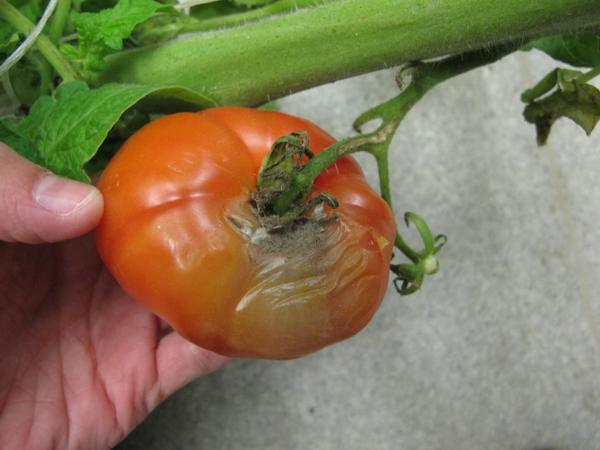
Caused by the fungus, Botrytis cinerea, gray mold is responsible for a variety of diseases including damping off and blights. It affects the flowers, fruits, stems and foliage of over 200 species of plants, including many ornamental, fruits and vegetables such as tomato, cabbage, lettuce, strawberries and wine grapes. The fungus thrives in cool temperatures ( 60-75°F) and high humidity (not leaf wetness) and is spread by wind, air currents, tools and contact with workers. It overwinters in plant debris and organic soil matter and can be a problem in both the field and greenhouse. Photo Credit Shawn Butler, NCSU PDIC
The most common symptom of gray mold is a velvety gray fuzzy mass of spores. Stem infections are tan to brown and can girdle the whole stem resulting in wilting above the infection site. Symptoms on leaves may appear as V-shaped tan to brown dead lesions at the leaf tip. Both green and red fruit, on or off the plant, may be covered with gray fuzz and then develop a pale, soft, watery rot or have white rings or halos (ghost spots) that indicate partial infection that stopped. The fungus enters the plant through leaf scars and small wounds, and rapidly spreads.
Control
N.B. There are no known resistant cultivars at this time
- Remove infected plants immediately and dispose of them to reduce the spread of the fungus.
- Wash tools, hands, and clothing that may carry the disease.
- Use a 3 year crop rotation scheme with crops from other plant families
- Remove and dispose of above ground crop residual
- Water in the morning using drip irrigation to reduce the time that moisture is on the leaves
- Mulch plants to reduce the effects of rain splashing spores onto plants
- Increase air circulation by increasing space between plants or trimming excess foliage
- Spray with a solution of 1 tablespoon baking soda, 2 1/tablespoons vegetable oil, and 1 teaspoon of liquid soap (not detergent) per gal of water. Repeat every 2 weeks, more often if rain washes the solution away.
- Spray with a prepared solution of Bacillus subtilis about every 2 weeks or when rain has washed it off the leaves.
- For very severe infestations spray with copper or sulfur, heeding cautionary warnings on the containers, and are more demanding solutions to the problem and the copper application will require special equipment.